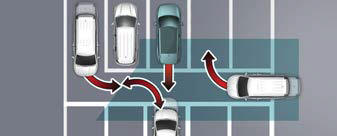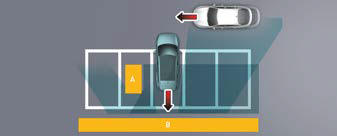Kia Sportage: Rear Cross-Traffic Collision-Avoidance Assist malfunction and limitations
Rear Cross-Traffic Collision- Avoidance Assist malfunction

A: Check Rear Cross-Traffic Safety system
When Rear Cross-Traffic Collision- Avoidance Assist is not working properly, the warning message will appear and the master warning light ( ) will appear on the cluster. Have the function be inspected by an authorized Kia dealer.

A: Check side view mirror warning light
When the outside rear view mirror warning
light is not working properly, the
warning message will appear and the
master warning light ( ) will appear
on
the cluster. Have the function beinspected
by an authorized Kia dealer.
) will appear
on
the cluster. Have the function beinspected
by an authorized Kia dealer.
Rear Cross-Traffic Collision- Avoidance Assist disabled

A: Rear Cross-Traffic Safety system disabled. Radar blocked
When the rear bumper around the rear corner radar or rear sensor is covered with foreign material, such as snow or rain, or installing a trailer or carrier, it can reduce the detecting performance and temporarily limit or disable Rear Cross- Traffic Collision-Avoidance Assist.
If this occurs, the warning message will appear on the cluster. But it is not a Rear Cross-Traffic Collision-Avoidance Assist malfunction.
The function will operate normally when such foreign material or trailer, etc. is removed. Always keep it clean.
If the function does not operate normally after it is removed, have the function inspected by an authorized Kia dealer
WARNING
- Even though the warning message or warning light does not appear on the cluster, Rear Cross-Traffic Collision- Avoidance Assist may not operate properly.
- Rear Cross-Traffic Collision-Avoidance Assist may not operate properly in an area or contaminated (for example: open terrain), where any substance are not detected after turning ON the vehicle.
CAUTION
Turn off Rear Cross-Traffic Collision- Avoidance Assist to install a trailer, carrier, etc., or remove the trailer, carrier, etc. to use Rear Cross-Traffic Collision- Avoidance Assist.
Limitations of Rear Cross-Traffic Collision-Avoidance Assist
Rear Cross-Traffic Collision-Avoidance Assist may not operate normally, or the function may operate unexpectedly under the following circumstances:
- Departing from where trees or grass are overgrown
- Departing from where roads are wet
- Speed of the approaching vehicle is fast or slow
Braking control may not work, driver's attention is required in the following circumstances:
- The vehicle severely vibrates while driving over a bumpy road, uneven road or concrete patch
- Driving on a slippery surface due to snow, water puddle, ice, etc.
- The tire pressure is low or a tire is damaged
- The brake is reworked
NOTICE
For more details on the limitations of the rear corner radar, refer to "Blind-Spot Collision-Avoidance Assist (BCA) (if equipped)"
WARNING
- Driving near a vehicle or structure
 [A]: Structure
[A]: Structure
Rear Cross-Traffic Collision-Avoidance Assist may be limited when driving near a vehicle or structure, and may not detect the vehicle approaching from the blind spot area. If this occurs, the function may not warn the driver or control the brakes when necessary.
Always check your surroundings while Reversing.
- When the vehicle is in a complex parking environment
 Rear Cross-Traffic
Collision-Avoidance
Assist may detect vehicles which
are parking or pulling out near your
vehicle (for example: a vehicle leaving
beside your vehicle, a vehicle parking
or pulling out in the rear area, a vehicle
approaching your vehicle making
a turn, etc.). If this occurs, the function
may unnecessarily warn the driver
and control the brake.
Rear Cross-Traffic
Collision-Avoidance
Assist may detect vehicles which
are parking or pulling out near your
vehicle (for example: a vehicle leaving
beside your vehicle, a vehicle parking
or pulling out in the rear area, a vehicle
approaching your vehicle making
a turn, etc.). If this occurs, the function
may unnecessarily warn the driver
and control the brake.
Always check your surroundings while Reversing.
- When the vehicle is parked diagonally
 [A]: Vehicle
[A]: Vehicle
Rear Cross-Traffic Collision-Avoidance Assist may be limited when Reversing diagonally, and may not detect the vehicle approaching from the blind spot area. If this occurs, the function may not warn the driver or control the brakes when necessary.
Always check your surroundings while Reversing.
- When the vehicle is on or near a slope
 Rear Cross-Traffic
Collision-Avoidance
Assist may be limited when the
vehicle is on a uphill or downhill slope,
or near it, and may not detect the
vehicle approaching from the blind
spot area. If this occurs, the function
may not warn the driver or control the
brakes when necessary.
Rear Cross-Traffic
Collision-Avoidance
Assist may be limited when the
vehicle is on a uphill or downhill slope,
or near it, and may not detect the
vehicle approaching from the blind
spot area. If this occurs, the function
may not warn the driver or control the
brakes when necessary.
Always check your surroundings while Reversing.
- Pulling into the parking space where there is a structure
 [A]: Structure, [B]:
Wall
[A]: Structure, [B]:
Wall
Rear Cross-Traffic Collision-Avoidance Assist may detect vehicles passing by in front of you when parking backwards into a parking space with a wall or structure in the rear or side area. If this occurs, the function may unnecessarily warn the driver and control the brake.
Always check your surroundings while Reversing.
- When the vehicle is parked rearward
 Rear Cross-Traffic
Collision-Avoidance
Assist may detect vehicles passing
by behind you when parking
backwards into a parking space. If this
occurs, the function may unnecessarily
warn the driver and control the
brake.
Rear Cross-Traffic
Collision-Avoidance
Assist may detect vehicles passing
by behind you when parking
backwards into a parking space. If this
occurs, the function may unnecessarily
warn the driver and control the
brake.
Always check your surroundings while Reversing.
WARNING
- When you are towing a trailer or another vehicle, do not use Rear Cross-Traffic Collision-Avoidance Assist. The function could destabilize the vehicle.
- Rear Cross-Traffic Collision-Avoidance Assist may not operate suddenly if interfered by strong electromagnetic waves.
- Rear Cross-Traffic Collision-Avoidance Assist may not operate for 15 seconds after the vehicle is started, or the rear corner radars are initialized.
This device complies with Part 15 of the FCC rules.
Operation is subject to the following two conditions:
- This device may not cause harmful interference, and
- This device must accept any interference received, including interference that may cause undesired operation.
READ NEXT:
 Reverse Parking Distance Warning settings
Reverse Parking Distance Warning settings
Reverse Parking Distance Warning will
help warn the driver if a person, an animal
or an object is detected within a certain
distance when the vehicle is moving
in reverse.
Detecting sensor
R
 Reverse Parking Distance Warning malfunction and
precautions
Reverse Parking Distance Warning malfunction and
precautions
Reverse Parking Distance Warning malfunction
After starting the vehicle, a beep will
sound once when the gear is shifted to R
(Reverse) to indicate Reverse Parking
Distance Warning is operating no
SEE MORE:
 Ultrasonic Sensor
Ultrasonic Sensor
Components and
Components Location
Components Location
Repair procedures
Removal
1. Lift up the vehicle.
(Refer to GI group - "Lift and support points")
2. Remove the rear bumper.
(Refer to the BD group - "Rear bumper")
3. Pull out the sensor by opening the s
 Tire terminology and definitions
Tire terminology and definitions
Refer to the following for detailed
definitions of the terms that are
found in the tire description.
Air Pressure The amount of air
inside the tire pressing outward on
the tire. Air pressure is expressed in
pounds per square inch (psi) or kilopascal
(kPa).
Accessory Weight The combined
we
Content
- Home
- Kia Sportage - Fifth generation (NQ5) - (2022-2025) - Owner's Manual
- Kia Sportage - Second generation (JEKM) (2005-2015) - Body Workshop Manual
- Kia Sportage Third generation (SL) - (2011-2016) - Service and Repair Manual
- Sitemap
- Top articles